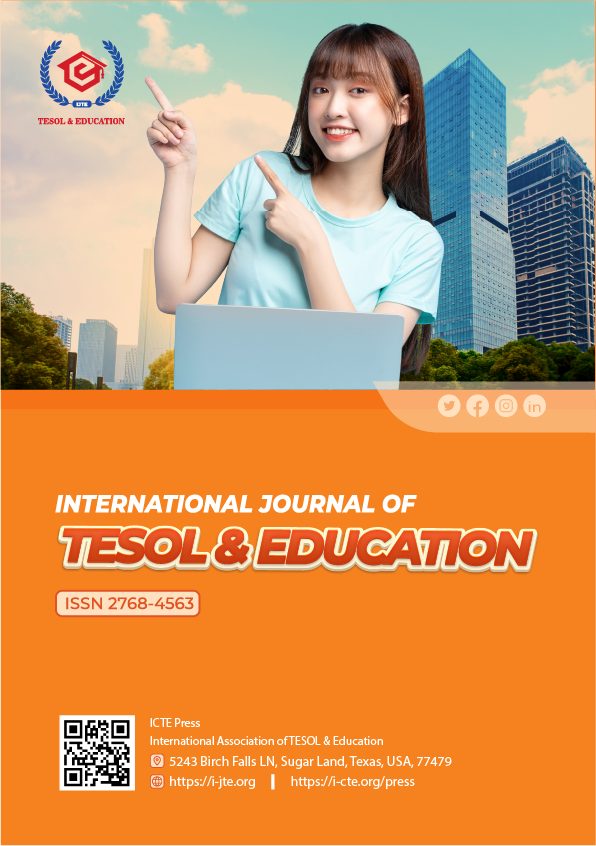Sequencing Research Writing and Research Methodology Courses: Implications from Students’ Course Evaluation
DOI:
https://doi.org/10.54855/ijte.25544Keywords:
course sequencing, Research Writing, Research Methodology, CIPP ModelAbstract
The purpose of this study is to examine if there are any significant differences in Research Writing course evaluation made by English Linguistics (EL) students learning Research Writing (RW) before Research Methodology (RM) (group 1) and those learning RW after RM (group 2) at the International University – Vietnam National University (IU-VNU), from which students' perceptions towards the sequencing of the two courses are discovered. Initially, a questionnaire was designed to collect the RW course evaluation from 119 EL students in both groups. Subsequently, the Mann-Whitney U test was employed to identify which questionnaire items showed significant differences between group 1 and group 2 responses, from which interview prompts were developed to elicit interviewees’ perceptions of RM-RW course sequencing in both groups. The study revealed that four items showed significant differences between group 1 and group 2’s evaluations. Moreover, all interviewees perceived that taking RW after RM helped facilitate RW learning more than taking RW before RM. These findings may suggest that RW should be required to learn after RM to improve the performance of IU EL students in the RW course.
References
Al-Barrak, M. A., & Al-Razgan, M. (2016). Predicting students final GPA using decision trees: A case study. International Journal of Information and Education Technology, 6(7), 528–533. https://doi.org/10.7763/IJIET.2016.V6.745
Allen, T. (2002). Charting a communication pathway: Using assessment to guide curriculum development in a re-vitalized general education plan. Communication Education, 51(1), 26–39. https://doi.org/10.1080/03634520216502
Betancur, L., Rottman, B. M., Votruba-Drzal, E., & Schunn, C. (2019). Analytical assessment of course sequencing: The case of methodological courses in psychology. Journal of Educational Psychology, 111(1), 91–103. https://doi.org/10.1037/edu0000269
Creswell, J. W., & Clark, V. L. P. (2011). Designing and conducting mixed methods research. SAGE.
Davaatseren, A., Myagmar, M., & Dulamsuren, N. (2024). Factors affecting students’ academic performance: (In the case of the accounting study of national university of Mongolia). In H. Batmend & O. Ganbold (Eds.), Proceedings of the Conference on Quality Assurance in Higher Education: Transforming Education-new Generation of Learners (QAHE 2023) (Vol. 18, pp. 39–44). Atlantis Press International BV. https://doi.org/10.2991/978-94-6463-382-5_6
David Kolo, K., A. Adepoju, S., & Kolo Alhassan, J. (2015). A decision tree approach for predicting students academic performance. International Journal of Education and Management Engineering, 5(5), 12–19. https://doi.org/10.5815/ijeme.2015.05.02
Deng, Z. (2015). Organization and sequencing of subject matters. In The SAGE guide to curriculum in education (Vol. 10, p. 78). SAGE Publications. https://books.google.com/books?hl=vi&lr=&id=MvwOCgAAQBAJ&oi=fnd&pg=PA78&dq=curriculum+sequencing+importance&ots=7DQTlUUIM8&sig=BoZkDUIHOg5J1z-wSVnhJUmVA1A
Dr. Muhammad Idris, Dr. Sajjad Hussain, & Dr. Nasir Ahmad. (2020). Relationship between parents’ education and their children’s academic achievement. Journal of Arts & Social Sciences, 7(2), 82–92. https://doi.org/10.46662/jass-vol7-iss2-2020(82-92)
Hair, J. F., Black, W. C., & Babin, B. J. (2010). Multivariate Data Analysis: A Global Perspective. Pearson Education.
Igere, M. A. (2017). Career choice and its influence on academic performance of library and information science students in a Nigerian university. Information Impact: Journal of Information and Knowledge Management, 8(2), 90–98. https://doi.org/10.4314/iijikm.v8i2.8
Kroll, T., & Neri, M. (2009). Designs for mixed methods research. In S. Andrew & E. J. Halcomb (Eds.), Mixed Methods Research for Nursing and the Health Sciences (1st ed., pp. 31–49). Wiley. https://doi.org/10.1002/9781444316490.ch3
Kumar, R. (2010). Research methodology: A step-by-step guide for beginners. SAGE.
Le, X. M., & Le, T. T. (2022). Factors Affecting Students’ Attitudes towards Learning English as a Foreign Language in a Tertiary Institution of Vietnam. International Journal of TESOL & Education, 2(2), 168–185. https://doi.org/10.54855/ijte.22229
Maitra, S., Shivakumar, R., & MallikarjunaBabu, K. (2015). Importance of course sequencing in overall learning. 2015 IEEE 3rd International Conference on MOOCs, Innovation and Technology in Education (MITE), 204–207. https://doi.org/10.1109/mite.2015.7375315
Marcenaro–Gutierrez, O., Lopez–Agudo, L. A., & Ropero-García, M. A. (2018). Gender differences in adolescents’ academic achievement. YOUNG, 26(3), 250–270. https://doi.org/10.1177/1103308817715163
Masrai, A., El-Dakhs, D. A. S., & Yahya, N. (2022). What Predicts academic achievement in EMI courses? Focus on vocabulary knowledge and self-perceptions of L2 skills. Sage Open, 12(2). https://doi.org/10.1177/21582440221101044
Mathison, S. (2005). Encyclopedia of evaluation. SAGE.
Montolio, D., & Taberner, P. A. (2021). Gender differences under test pressure and their impact on academic performance: A quasi-experimental design. Journal of Economic Behavior & Organization, 191, 1065–1090. https://doi.org/10.1016/j.jebo.2021.09.021
Moral-García, J. E., Urchaga-Litago, J. D., Ramos-Morcillo, A. J., & Maneiro, R. (2020). Relationship of parental support on healthy habits, school motivations and academic performance in adolescents. International Journal of Environmental Research and Public Health, 17(3), 882. https://doi.org/10.3390/ijerph17030882
Muttaqin, S., Chuang, H.-H., Lin, C.-H., & Cheng, M.-M. (2022). When proficiency and education matter: The mediating role of English proficiency and moderating effect of parents’ education in the SES–academic achievement relationship during EMI. Sage Open, 12(2). https://doi.org/10.1177/21582440221103542
Nahar, K., Shova, B. I., Ria, T., Rashid, H. B., & Islam, A. H. M. S. (2021). Mining educational data to predict students performance: A comparative study of data mining techniques. Education and Information Technologies, 26(5), 6051–6067. https://doi.org/10.1007/s10639-021-10575-3
Newton, M. H., & Kinskey, M. (2021). The association between course context and preservice teachers’ perceptions of SSI instruction. In W. A. Powell (Ed.), Advances in Educational Technologies and Instructional Design (pp. 192–222). IGI Global. https://doi.org/10.4018/978-1-7998-4558-4.ch007
Peat, J., Elliott, E., Baur, L., & Keena, V. (2013). Scientific writing: Easy when you know how (1st ed.). BMJ Books. https://www.perlego.com/book/1006571/scientific-writing-easy-when-you-know-how-pdf
Richards, A. S. (2012). Course sequencing in the communication curriculum: A case study. Communication Education, 61(4), 395–427. https://doi.org/10.1080/03634523.2012.713500
Scriven, M. (1991). Evaluation thesaurus. SAGE.
Sijtsma, K. (2009). On the use, the misuse, and the very limited usefulness of Cronbach’s alpha. Psychometrika, 74(1), 107–120. https://doi.org/10.1007/s11336-008-9101-0
Sopha, S., & Nanni, A. (2019). The CIPP model: Applications in language program evaluation. The Journal of AsiaTEFL, 16(4), 1360–1367. https://doi.org/10.18823/asiatefl.2019.16.4.19.1360
Stufflebeam, D. L. (2003). The CIPP Model for Evaluation. In T. Kellaghan & D. L. Stufflebeam (Eds.), International Handbook of Educational Evaluation (pp. 31–62). Springer Netherlands. https://doi.org/10.1007/978-94-010-0309-4_4
Stufflebeam, D. L., & Zhang, G. (2017). The CIPP evaluation model: How to evaluate for improvement and accountability. Guilford Publications.
Tran, T. T. N. (2022). The effects of task-based instructions on secondary students’ reading performances. International Journal of Language Instruction, 1(1), 9–18. https://doi.org/10.54855/ijli.22112
Vedung, E. (2017). Public policy and program evaluation. Transaction Publishers.
Von Allmen, P. (1996). The effect of quantitative prerequisites on performance in intermediate microeconomics. Journal of Education for Business, 72(1), 18–22. https://doi.org/10.1080/08832323.1996.10116820
Woosley, S. A., Truell, A. D., Alexander, M. W., & Zhao, J. J. (2010). Course seuqencing and performance: An investigation of using business college requirements in relation to an information systems core course. Issues In Information Systems, XI(1). https://doi.org/10.48009/1_iis_2010_559-565
Xu, X., Wang, J., Peng, H., & Wu, R. (2019). Prediction of academic performance associated with internet usage behaviors using machine learning algorithms. Computers in Human Behavior, 98, 166–173. https://doi.org/10.1016/j.chb.2019.04.015
Downloads
Published
Issue
Section
License
Copyright (c) 2025 Nguyen Hoang Quynh Anh, Dao Nguyen Anh Duc

This work is licensed under a Creative Commons Attribution 4.0 International License.
The copyright of all articles published in the International Journal of TESOL & Education (ijte) remains with the Authors, i.e. Authors retain full ownership of their article. Permitted third-party reuse of the open access articles is defined by the applicable Creative Commons (CC) end-user license which is accepted by the Authors upon submission of their paper. All articles in the ijte are published under the CC BY-NC 4.0 license, meaning that end users can freely share an article (i.e. copy and redistribute the material in any medium or format) and adapt it (i.e. remix, transform and build upon the material) on the condition that proper attribution is given (i.e. appropriate credit, a link to the applicable license and an indication if any changes were made; all in such a way that does not suggest that the licensor endorses the user or the use) and the material is only used for non-commercial purposes.
Authors retain copyright and grant the journal the right of first publication with the work simultaneously licensed under a Creative Commons Attribution 4.0 International License that allows others to share the work with an acknowledgment of the work's authorship and initial publication in this journal.
Authors are able to enter into separate, additional contractual arrangements for the non-exclusive distribution of the journal's published version of the work (e.g., post it to an institutional repository, in a journal or publish it in a book), with an acknowledgment of its initial publication in this journal.











